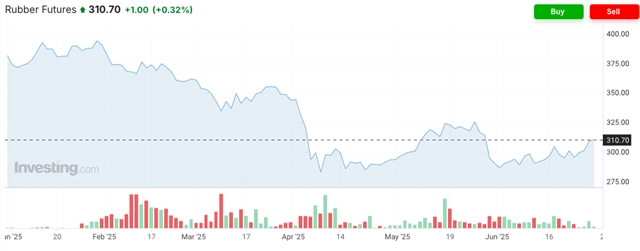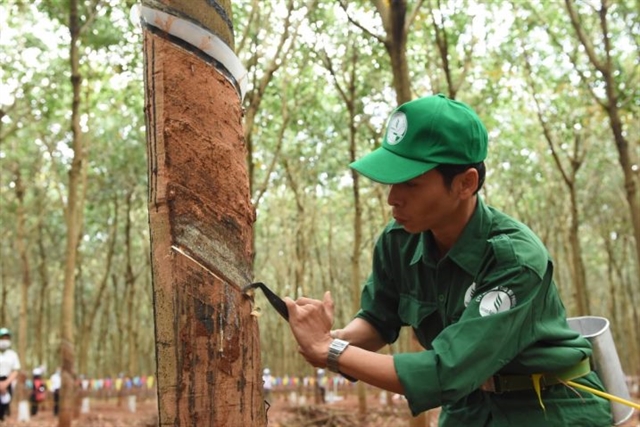Since late February, natural rubber prices have dropped sharply by over 17 per cent, sliding from 375 Japanese yen (US$2.60) per kg to around 310.7 ($2.15) per kg on June 30.
HÀ NỘI — Việt Nam’s natural rubber industry is facing mounting challenges, with listed rubber stocks lagging behind the broader market as companies grapple with falling global rubber prices and a slowdown in land conversion projects, two major drivers of their earnings.
As pressures on both revenue and asset strategy intensify, investors are finding little momentum in a sector traditionally seen as a blend of agriculture and industrial real estate.
Since late February, natural rubber prices have dropped sharply by over 17 per cent, sliding from 375 Japanese yen (US$2.60) per kg to around 310.7 ($2.15) per kg on June 30.

This steep decline is largely attributed to aggressive price competition among Chinese automakers.
In an effort to offload inventory and stimulate demand amid weak consumer sentiment, many manufacturers have implemented large-scale discount campaigns across both electric and internal combustion engine vehicle models.
This wave of price cuts has driven down tyre prices globally, affecting demand for natural rubber — the primary raw material in tyre production.
Notably, the tyre industry accounts for about 70 per cent of global natural rubber consumption.
As a result, rubber-producing countries, including Việt Nam, are seeing export prices fall just as seasonal supply is beginning to rise.
While Việt Nam’s rubber trees enter peak harvesting season between June and October, the expected increase in output could exert additional pressure on prices.
Market analysts warn that unless global demand recovers significantly, the domestic sector could face a further erosion of margins in the second half of the year.
At a recent general meeting, Trương Minh Trung, deputy CEO of Vietnam Rubber Group (GVR), acknowledged the volatility but maintained cautious optimism.
He noted that in the first months of 2025, rubber prices averaged VNĐ50 million per tonne ($1,917), a notable improvement compared to the 2024 average of VNĐ43 million.
“We forecast that average prices this year may settle between VNĐ45-47 million per tonne, likely exceeding last year’s levels,” Trung said.
However, not all market observers share that outlook.
A report by MB Securities offers a more conservative forecast, estimating that rubber prices will decline to VNĐ44.6 million in 2026 and VNĐ42.4 million in 2027.
The anticipated downward trend reflects expectations of softer global demand combined with rising output across key supplier markets.
The negative pricing outlook has translated directly into underperformance in the equity market.

While the VN-Index has surged more than 25.7 per cent from April 9 to June 30, driven by strong gains in the banking, technology and industrial sectors, rubber stocks have remained subdued.
Phuoc Hoa Rubber JSC (PHR) posted a gain of 3.6 per cent during the same period, Dong Phu Rubber JSC (DPR) rose 18.2 per cent and Dak Lak Rubber Investment JSC (DRI) was the standout performer with a 51.7 per cent increase.
Still, since the end of March, when rubber prices began their most recent decline, PHR has fallen by 5.2 per cent, DPR by 15.4 per cent and DRI by 6.4 per cent, even as the broader index gained 5.2 per cent.
Structural factors also weigh heavily on the sector’s outlook.
The three major listed rubber companies — PHR, DPR and DRI — each manage more than 9,000ha of plantation land. However, many of these plantations are ageing.
DRI, for instance, planted a large portion of its trees between 2005 and 2008, meaning much of its crop is now in the 17- to 20-year age range and nearing the end of its productive cycle.
Additionally, storms and extreme weather conditions in the Central Highlands and southeastern regions have taken a toll on plantation health and yield.
In recent years, a key source of income for rubber companies has come from the conversion of plantation land into industrial parks and other real estate developments.
Phuoc Hoa Rubber has been pursuing plans to convert up to 2,800ha of land into urban and industrial projects.
Dong Phu Rubber has also invested in the Bắc Đồng Phú and Nam Đồng Phú industrial clusters. These initiatives have helped supplement earnings and support stock valuations during periods of weak rubber pricing.
However, the pace of land conversion has slowed markedly in 2025, largely due to geopolitical uncertainty.
Reports that the United States may impose retaliatory tariffs on certain Vietnamese exports have created hesitation among companies and local authorities in pushing forward large-scale industrial projects. The delay in approvals and investment has weakened a major growth lever for the rubber firms.
As a result, technical indicators on the Ho Chi Minh Stock Exchange (HoSE) show limited recovery signals for rubber stocks. Market liquidity remains low, and investor sentiment has been cautious, with many choosing to rotate capital into more dynamic sectors.
Looking ahead, the recovery of Việt Nam’s natural rubber sector will depend on a combination of global demand revival, particularly from the auto and tyre industries, stabilisation in commodity prices and clearer policy direction on land conversion.
Until those catalysts materialise, the sector is likely to remain under pressure, both fundamentally and in investor perception. — BIZHUB/VNS





